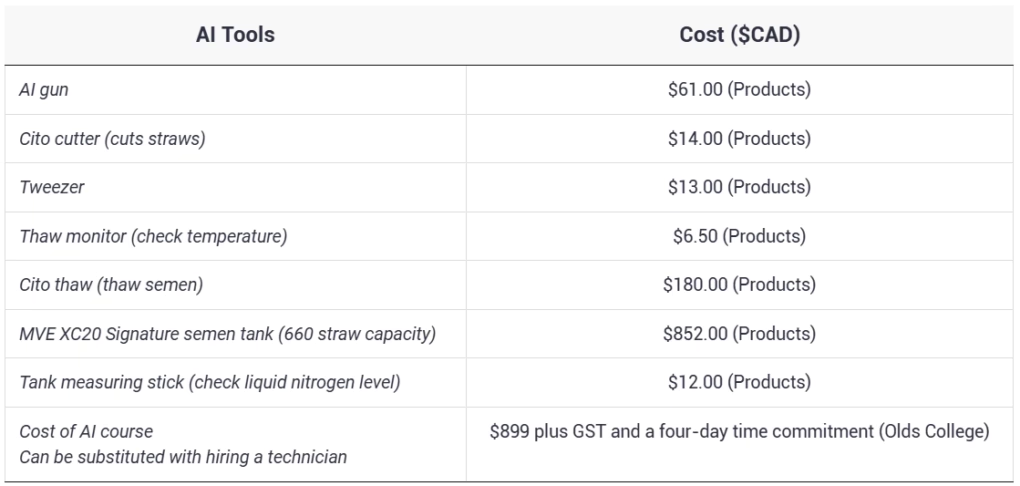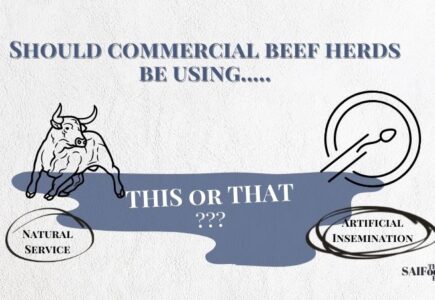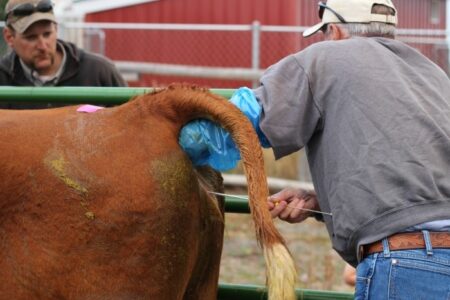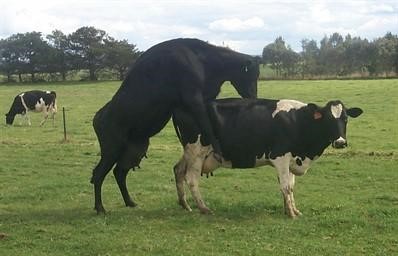By Julie Sharp,
University of Saskatchewan Student
I grew up on a beef cow/calf farm in Central Alberta which raises purebred Angus cattle, which we breed, calves, and raise until weaning. At weaning in the fall, we select our top female calves to keep or sell as breeding stock, and a select group of male calves to sell to other farmers as bulls. All other calves are then sold to feedlots. This is a pretty common practice for purebred cow/calf farms in Western Canada. My family uses a blend of two breeding methods:naturally with a bull (natural service or NS) or through artificial insemination (AI). Which I thought was a little less common practice these days.
When I attended AI school, more than half of the participants were commercial cattle producers. I was surprised at the number that was beginning to implement AI into their herds being that is not standard practice. Commercial cattle producers typically raise cattle that are a blend of breeds and sell all calves, except a select group of female calves to raise calves themselves, to feed lots for finishing. Commercial producers generally use only natural breeding as it is less labour intensive, whereas purebred breeders often incorporate AI to improve genetics. As of 2019, only 7.6% of United States beef operations use AI (Hall, 2019). While I was surprised by the number of commercial producing learning to implement AI, after hearing their reasoning it made sense. I learned that doing so as it means spending less money on buying and maintaining bulls for natural service, and offers faster genetic progress, providing greater returns at the time of sale. This then made me wonder why there are not more commercial cattlemen doing the same. For years, AI has been used in purebred herds to make quicker genetic progress, but its use in commercial herds is still limited. Despite its limited commercial use so far, AI is one of the cheapest and quickest ways to improve the quality of a beef herd and increase profits over time (Williamson, 2015).
Advantages of AI
Artificial insemination programs have many benefits for commercial producers. With AI a producer has a far larger range of bulls to choose from in their price range, as compared to the limitations producers have when relying on a bull to impregnate your herd. Producers’ choice of AI bulls can lead to a more accurate selection for superior weaning weight, yearling weight, feedlot performance, and carcass characteristics, all of which improve profitability (Palmer & Mapletoft, 2019). In one study, heifers bred from AI bulls weaned calves 73lbs higher on average than those bred by NS (Hall, 2019). That’s a substantial payout difference when commercial beef producers get paid by the pound. A study that included three commercial beef herds in Saskatchewan had a net increase in profits of $87.56/animal using AI for the first heat cycle of the breeding season (Rudy Feeder Co-operative Ltd., 2014).
The use of AI over NS can also decrease the occurrence of tough births in heifers because bulls have been used more, proving their calving ease (Palmer & Mapletoft, 2019). When you rely on NS of a newer bull, you will have less data on calves, whereas there is more data available before the purchase of the typical calves that have resulted from the selected AI bulls’ semen. The selection of an AI bull can also be made based on the data on milk production, docility, calving ease, maternal calving ease, and birth weight (Williamson, 2015).
Other advantages of an AI program include that half as many bulls are needed (Rudy Feeder Co-operative Ltd., 2015). Natural service bulls are typically exposed to 25 females for 42-63 days. In most beef AI programs, females receive AI in the first 21 days of the breeding season, and then they expose these females to an NS bull for 21-42 days to ensure that insemination has occurred (Rudy Feeder Co-operative Ltd., 2015). A large number of females should be bred in the first 21 days, so a bull can be exposed to more females for the later part of the breeding season effectively reducing the number of NS bulls needed. Additionally, genetics from all over the world can be used more easily in an AI program creating more variety in the choice of bulls to utilize (Williamson, 2015).
Management
Even though AI has great potential to improve a herd, it is not always the right path for every operation. Females in an AI program require far higher levels of management than those in an NS program. Females require proper body condition and proper nutrition before and after calving (Palmer & Mapletoft, 2019). Females who are not in proper condition have a far lower chance of conception and can decrease the improved profits of the AI program. While this is true for both types of breeding programs, it is especially important to the success of an AI program.
Costs
The costs of AI versus NS should be considered before implementing it in a program. In total for AI, it will cost about $95 per pregnancy (Hall, 2019). This rate however varies based on the price of semen, which is a reflection of the demand and popularity of the bulls’ traits, ranging from $10-$30 CAD per insemination (Palmer and Mapletoft, 2019). With AI, you also have the cost of the labour by the AI technician, however, with an AI course, you can perform AI yourself. For an NS, your cost is the bull itself. Most quality bulls going to commercial programs are around $5000 USD to purchase a bull. Bulls may also be rented or purchased through shares with other farmers. A bull will last for an average of three years. When loss of use is considered, alongside the cost of feeding and maintaining the bull, and its sale price, most bulls will inseminate an average of 25 cows, making the cost per pregnancy $90.59 USD (~$113 CAD). For a $5000 bull, the cost of AI is comparable (Hall, 2019).
Table 1: One time cost tools (CAD)

Table 2: Other tools needed that constantly need replacing depending on number of head AI’ed (CAD) (Products)

Disadvantages
While AI has many advantages, there are still disadvantages. AI is more labour intensive than NS. Natural heat detection of female cows is time-consuming and 25-50% of heats are undetected due to human limitations (Palmer & Mapletoft, 2019). Time is also required to AI cows.
Who should use AI in their herds?
Ultimately, AI should only be implemented in programs where there is already excellent management in place and attention to detail will be implemented during the breeding season. Operations implementing AI should speak with their veterinarian, semen sales representative and nutritionist before implementation and regularly throughout the year. The costs are nearly the same or slightly more than natural service breeding depending on the cost of semen used. Artificial insemination requires added labour, but results in higher quality genetics in the herd and higher profitability when calves go to market.
Olds College. (n.d.). Cattle Artificial Insemination. https://www.oldscollege.ca/programs/continuing-education/animal-science/cattle-artificial-insemination/index.html.
Hall, J. B. (2019, November 18-20). Capturing the Value of Artificial Insemination in Commercial Herds [Conference presentation]. The Range Beef Cow Symposium XXVI, Mitchell, NE, United States. https://beef.unl.edu/documents/RBC-Symposium/2019/RBCS-2019-03-Capturing-the-Value-of-Artificial-Insemination-in-Commercial-Herds.pdf.
McBride, R. (2018, March 15). Signs your cow or Heifer is in heat. Moocall. https://www.moocall.com/signs-your-cow-or-heifer-is-in-heat/.
Palmer, C., & Mapletoft, R. J. (2019, July 2). Artificial insemination. Beef Cattle Research Council. https://www.beefresearch.ca/research-topic.cfm/artificial-insemination-17.
GENEX. (n.d.). Products. https://www.genexcanada.ca/products/.
Rudy Feeder Co-operative Ltd. (2014, April). Estrous Synchronization & Artificial Insemination in Commercial Beef Production. Government of Saskatchewan. https://library.usask.ca/gp/sk/da/adf/20110343.pdf.
Rudy Feeder Co-operative Ltd. (2015, June). A Continuation of Estrous Synchronization and Artificial Insemination in Commercial Beef Production. Government of Saskatchewan. https://library.usask.ca/gp/sk/da/adf/20120435.pdf.
Williamson, B. (2015, August 5). Using artificial insemination in a commercial breeding herd. Penn State Extension. https://extension.psu.edu/using-artificial-insemination-in-a-commercial-breeding-herd.
Winger, J. (2018, March 17). Breeding Your Cow With Artificial Insemination. The Prairie Homestead. https://www.theprairiehomestead.com/2015/08/breeding-cow-artificial-insemination.html.

Julie Sharp
Hi my name is Julie Sharp. I grew up on a purebred Angus cow/calf farm at Lacombe, Alberta. I am a second year student in the College of Agriculture and Bioresources at the University of Saskatchewan majoring in Animal Science and minoring in Ag Business. Growing up on a farm and being involved with 4-H and other agricultural activities sparked my passion for agriculture. I am interested in livestock genetics, production and nutrition.




